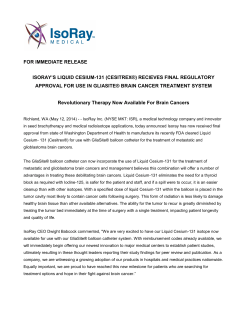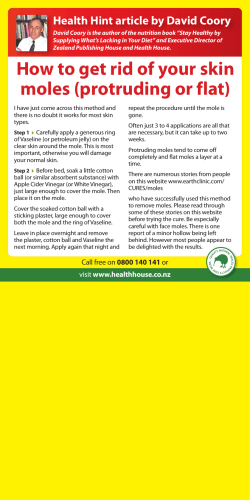
Spot the difference SKIN CANCERS WARNING SIGNS
Spot the difference SKIN CANCERS Melanoma Nodular melanoma See your doctor immediately if you see anything unusual or notice any changes to your skin Basal cell carcinoma Squamous cell carcinoma WARNING SIGNS HARMLESS SPOTS Solar keratoses or sunspots Moles CHECKING YOUR SKIN PREVENTION IS BETTER THAN CURE Most skin cancers are detected by people themselves or by a family member. If found early, most skin cancers can be successfully treated. Make sure you check your entire body as skin cancers can occur on parts of the body not exposed to the sun. Ask a friend or family member to check areas you cannot see, such as your scalp and back. See your doctor immediately if you see anything unusual or notice any changes to your skin. During sun protection times (when the UV is 3 or above), use a combination of: - Slip on sun-protective clothing. - Slop on SPF 30 or higher broad-spectrum sunscreen. - Slap on a hat. - Seek shade. - Slide on some sunglasses. Call 13 11 20 or visit sunsmart.com.au Seborrhoeic keratoses Check the sun protection times daily at sunsmart.com.au, in daily newspapers or on the SunSmart app. Spot the difference SKIN CANCERS Melanoma Nodular melanoma Most deadly form of skin cancer. • If left untreated can spread to other parts of the body. • Appears as a new spot or an existing spot that changes in colour, size or shape. • Can appear on skin not normally exposed to the sun. • • Common features of melanoma include: • One half of the spot does not match the other. • Edges are irregular, ragged, notched or blurred. • Colour is not the same all over. • Larger than 6mm across (about ¼ inch) or is growing larger. Grows quickly. • Looks different from common melanomas. Raised and even in colour. • Many are red or pink and some are brown or black. • They are firm to touch and dome-shaped. • After a while they begin to bleed and crust. Basal cell carcinoma Most common, least dangerous form of skin cancer. • Red, pale or pearly in colour, appears as a lump or dry, scaly area. • May ulcerate or fail to completely heal. • Grows slowly, usually on areas that are often exposed to the sun. • Squamous cell carcinoma A thickened, red scaly spot that may bleed easily, crust or ulcerate. Grows over some months, usually on areas often exposed to the sun. • More likely to occur in people over 50 years of age. • • WARNING SIGNS HARMLESS SPOTS Solar keratoses or sunspots Moles Seborrhoeic keratoses Harmless coloured spots that range from 1mm to 10mm. • Uniform in shape and even coloured. May be raised. • The more moles or freckles you have the higher your risk of skin cancer. • May have uneven borders and multiple colours like brown and black. • Observe moles carefully for any sign of change. • A warning sign that you are prone to skin cancer. • Red, flattish scaling dry skin that may sting if scratched. • Appears on areas of skin most often exposed to the sun, like hands and face. • Most common in people over 40 years of age. • • Spot with a very discrete edge that looks like it sits on top of the skin. • Colour varies from pale brown to orange or black. • Size varies from a few millimetres to two centimetres. • Most people have at least one or two of these spots by the age of 60. Some images gratefully provided by the Skin & Cancer Foundation Victoria April 2013
© Copyright 2026





















